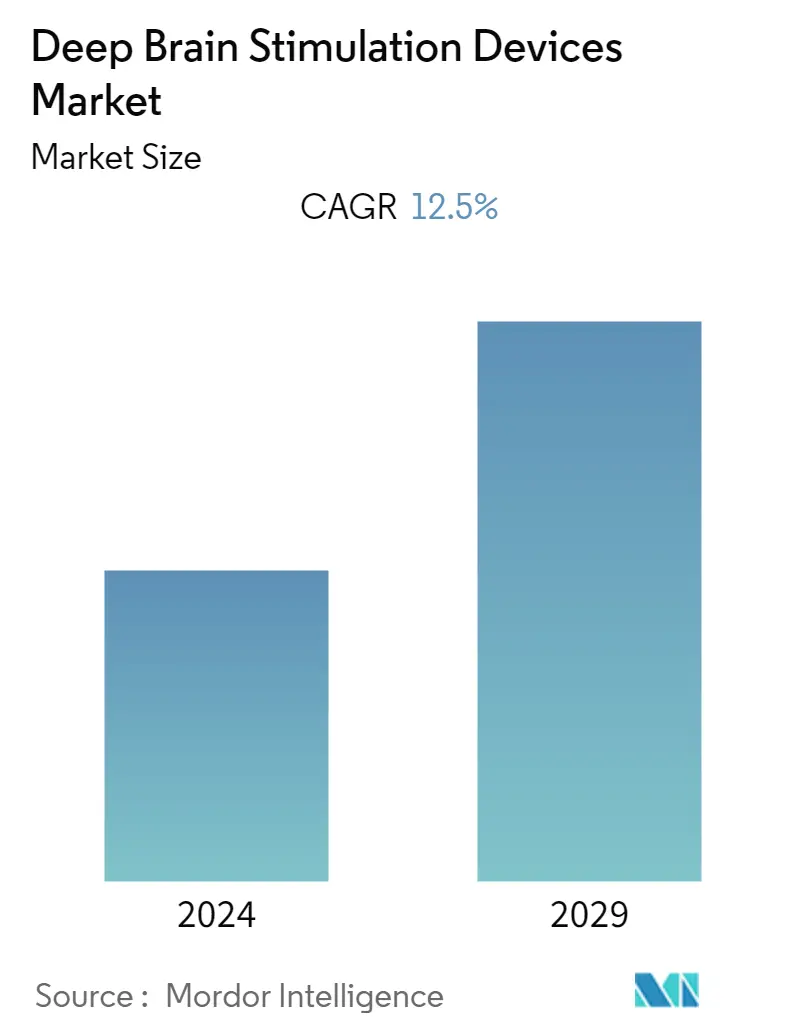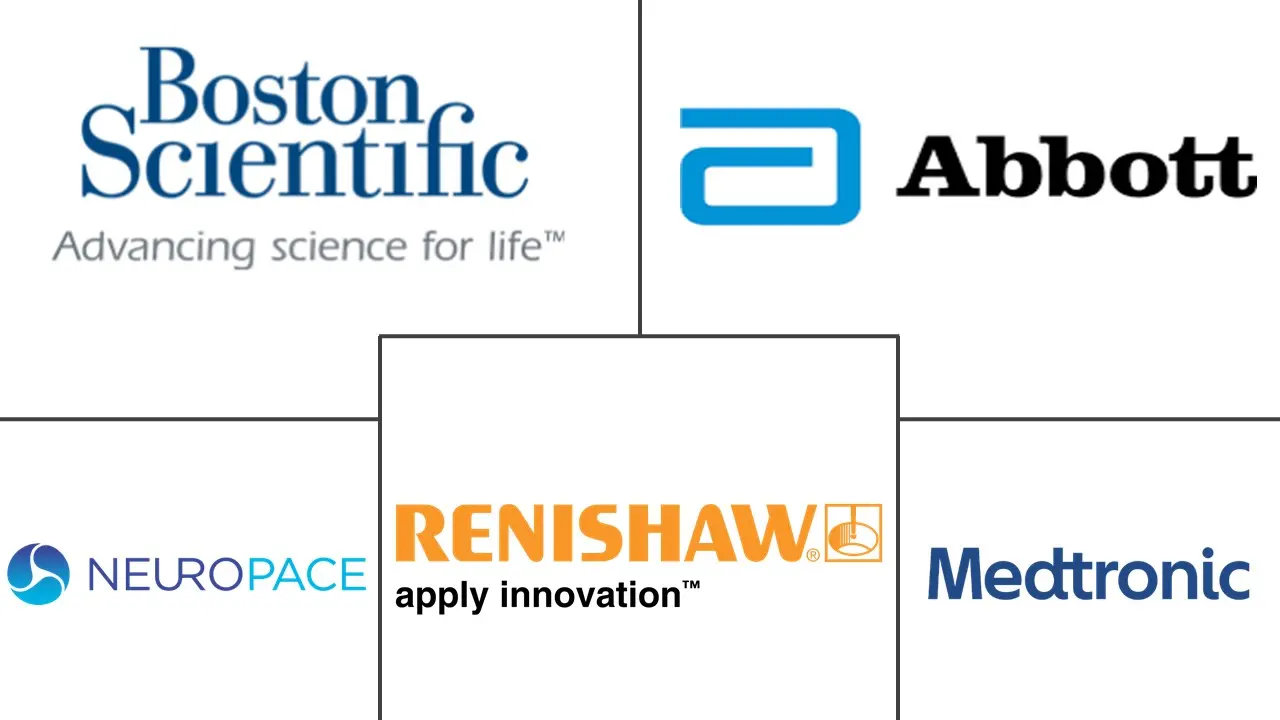
| Study Period | 2019 - 2029 |
| Base Year For Estimation | 2023 |
| Forecast Data Period | 2024 - 2029 |
| CAGR | 12.50 % |
| Fastest Growing Market | Asia Pacific |
| Largest Market | North America |
| Market Concentration | High |
Major Players
*Disclaimer: Major Players sorted in no particular order |
Deep Brain Stimulation Devices Market Analysis
The deep brain stimulation (DBS) devices market is expected to register a CAGR of nearly 12.5% during the forecast period.
The COVID-19 pandemic is expected to have a significant impact on market growth. The pandemic restrictions worsened motor and psychiatric symptoms in patients suffering from neurological disorders treated with deep brain stimulation (DBS) devices. The pandemic worsened the burden of brain disorders and surged the chronic stress related to deep brain stimulation management. According to the study published by the Neurologia Journal in August 2021, during the pandemic, the prevalence of COVID-19 in Parkinson's patients was 11.28%. However, COVID-19 in Parkinson's patients undergoing Deep Brain Stimulation (DBS) was 18.18%. Thus, the worsening of neurological disorders amongst COVID-19 patients encouraged the prominent players to develop novel DBS devices, significantly impacting the market growth. For instance, according to the article published by the Nature Journal in October 2022, the pandemic accelerated the adoption of DBS teleprogramming in countries like Hungary, present in the European region.
Furthermore, the prominent players actively assisted patients requiring DBS treatment during the pandemic. For instance, in March 2021, Abbott launched the NeuroSphere Virtual Clinic, allowing patients to connect with physicians and remotely safeguard DBS devices' proper settings and functionality. The US-FDA-approved NeuroSphere Virtual Clinic enhanced patient access to optimal treatment for patients suffering from chronic movement disorders who could not go to the healthcare clinic because of COVID-19 lockdowns. Therefore, looking at the overall scenario, the COVID-19 pandemic worsened the situation of patients suffering from neurological disorders. However, the market registered stable growth due to the increased adoption of remote solutions and is expected to witness significant growth during the forecast period.
DBS is a widely used treatment for advanced Parkinson's disease (PD), essential tremors, and dystonia. Over the past few years, in addition to the extension of its clinical applications, there has been tremendous growth in deep brain stimulation technology. The major factors driving the development of the market include the rapidly aging population, which is leading to risk and high prevalence of neurological disorders, growing demand for the devices due to the rising popularity of minimally invasive procedures, and availability of technologically advanced deep brain stimulation devices.
The rising prevalence of various neurological disorders like Epilepsy is projected to drive the market growth during the forecast period. For instance, according to the key facts published by the WHO in February 2023, approximately 50 million people worldwide have Epilepsy, making it one of the most common neurological diseases globally. As per the same source, about 80% of people with Epilepsy live in low- and middle-income countries. Furthermore, the prominent players are actively participating in the launch of advanced DBS devices in various countries worldwide, which is also burgeoning the market growth. For instance, in August 2022, Medtronic Private Limited, a subsidiary of Medtronic plc, launched the SenSight directional lead system for DBS therapy to treat movement disorders and Epilepsy in India. Similarly, in December 2022, Medtronic plc launched its DBS system, Percept PC, in South Korea to treat tremors and Parkinson's patients. Percept PC is equipped with BrainSense technology to provide electrical DBS treatment to neurological patients.
Therefore, the market is expected to grow significantly during the forecast period due to the abovementioned factors. However, risks associated with deep brain stimulation procedures and the implementation of stringent government policies are expected to hamper market growth during the forecast period.
Deep Brain Stimulation Devices Industry Segmentation
As per the scope of this report, a deep brain stimulator is a battery-operated medical device, which is also called a neurostimulator. It is used in neurosurgical procedures, to treat various disabling neurological symptoms. TThe deep brain stimulation devices market is segmented by product type (single-channel deep brain stimulator and dual-channel deep brain stimulator), by application (Parkinson's disease, essential tremor, obsessive-compulsive disorder, epilepsy, dystonia, and other applications), by end user (hospitals, ambulatory surgical centers, and other end users), and geography. (North America, Europe, Asia-Pacific, Middle East and Africa, and South America). The report also covers the estimated market sizes and trends for 17 countries across major regions globally. The report offers the value (in USD) for the above segments.
| Single-channel Deep Brain Stimulator |
| Dual-channel Deep Brain Stimulator |
| Parkinson's Disease |
| Essential Tremor |
| Obsessive Compulsive Disorder |
| Epilepsy |
| Dystonia |
| Other Applications |
| Hospitals |
| Ambulatory Surgical Centers |
| Other End Users |
| North America | United States |
| Canada | |
| Mexico | |
| Europe | Germany |
| United Kingdom | |
| France | |
| Italy | |
| Spain | |
| Rest of Europe | |
| Asia-Pacific | China |
| Japan | |
| India | |
| Australia | |
| South Korea | |
| Rest of Asia-Pacific | |
| Middle East and Africa | GCC |
| South Africa | |
| Rest of Middle East and Africa | |
| South America | Brazil |
| Argentina | |
| Rest of South America |
Deep Brain Stimulation Devices Market Size Summary
The deep brain stimulation (DBS) devices market is poised for substantial growth, driven by the increasing prevalence of neurological disorders such as Parkinson's disease, essential tremors, and dystonia. The market is experiencing a surge in demand due to the aging population and the rising popularity of minimally invasive procedures. Technological advancements in DBS devices are further propelling market expansion, with prominent players actively launching innovative solutions globally. The COVID-19 pandemic, while initially posing challenges, has accelerated the adoption of remote DBS management solutions, contributing to market resilience and growth. The introduction of teleprogramming and virtual clinics has enhanced patient access to treatment, even during lockdowns, underscoring the market's adaptability and potential for continued expansion.
Regionally, North America holds a significant share of the global DBS devices market, supported by a high prevalence of neurological disorders and the presence of key industry players. The region's market growth is further bolstered by frequent product launches and regulatory approvals for advanced DBS technologies. The market landscape is characterized by a few major players, including Abbott Laboratories, Boston Scientific Corporation, and Medtronic PLC, who are leading the charge in innovation and expansion. Despite challenges such as procedural risks and stringent government regulations, the market is expected to witness robust growth, driven by ongoing research, development activities, and strategic partnerships aimed at enhancing DBS technologies and expanding their clinical applications.
Deep Brain Stimulation Devices Market Size - Table of Contents
1. MARKET DYNAMICS
- 1.1 Market Overview
-
1.2 Market Drivers
- 1.2.1 Rapidly Aging Population, Leading to Risk and High Prevalence of Neurological Disorders
- 1.2.2 Growing Demand for the Devices, Due to Rising Popularity of Minimally Invasive Procedures
- 1.2.3 Availability of Technologically Advanced Deep Brain Stimulation Devices
-
1.3 Market Restraints
- 1.3.1 Risks Associated with Deep Brain Stimulation Procedures
- 1.3.2 Implementation of Government Policies Negatively Affecting the Market
-
1.4 Porter's Five Forces Analysis
- 1.4.1 Bargaining Power of Suppliers
- 1.4.2 Bargaining Power of Buyers/Consumers
- 1.4.3 Threat of New Entrants
- 1.4.4 Threat of Substitute Products
- 1.4.5 Intensity of Competitive Rivalry
2. MARKET SEGMENTATION (Market Size by Value-USD)
-
2.1 By Product Type
- 2.1.1 Single-channel Deep Brain Stimulator
- 2.1.2 Dual-channel Deep Brain Stimulator
-
2.2 By Application
- 2.2.1 Parkinson's Disease
- 2.2.2 Essential Tremor
- 2.2.3 Obsessive Compulsive Disorder
- 2.2.4 Epilepsy
- 2.2.5 Dystonia
- 2.2.6 Other Applications
-
2.3 By End User
- 2.3.1 Hospitals
- 2.3.2 Ambulatory Surgical Centers
- 2.3.3 Other End Users
-
2.4 Geography
- 2.4.1 North America
- 2.4.1.1 United States
- 2.4.1.2 Canada
- 2.4.1.3 Mexico
- 2.4.2 Europe
- 2.4.2.1 Germany
- 2.4.2.2 United Kingdom
- 2.4.2.3 France
- 2.4.2.4 Italy
- 2.4.2.5 Spain
- 2.4.2.6 Rest of Europe
- 2.4.3 Asia-Pacific
- 2.4.3.1 China
- 2.4.3.2 Japan
- 2.4.3.3 India
- 2.4.3.4 Australia
- 2.4.3.5 South Korea
- 2.4.3.6 Rest of Asia-Pacific
- 2.4.4 Middle East and Africa
- 2.4.4.1 GCC
- 2.4.4.2 South Africa
- 2.4.4.3 Rest of Middle East and Africa
- 2.4.5 South America
- 2.4.5.1 Brazil
- 2.4.5.2 Argentina
- 2.4.5.3 Rest of South America
Deep Brain Stimulation Devices Market Research FAQs
What is the current Global Deep Brain Stimulation Devices Market size?
The Global Deep Brain Stimulation Devices Market is projected to register a CAGR of 12.5% during the forecast period (2025-2030)
Who are the key players in Global Deep Brain Stimulation Devices Market?
Boston Scientific Corporation, Renishaw PLC, NeuroPace Inc., Beijing Pinchi Medical Equipment Co., Ltd. and Medtronic are the major companies operating in the Global Deep Brain Stimulation Devices Market.


